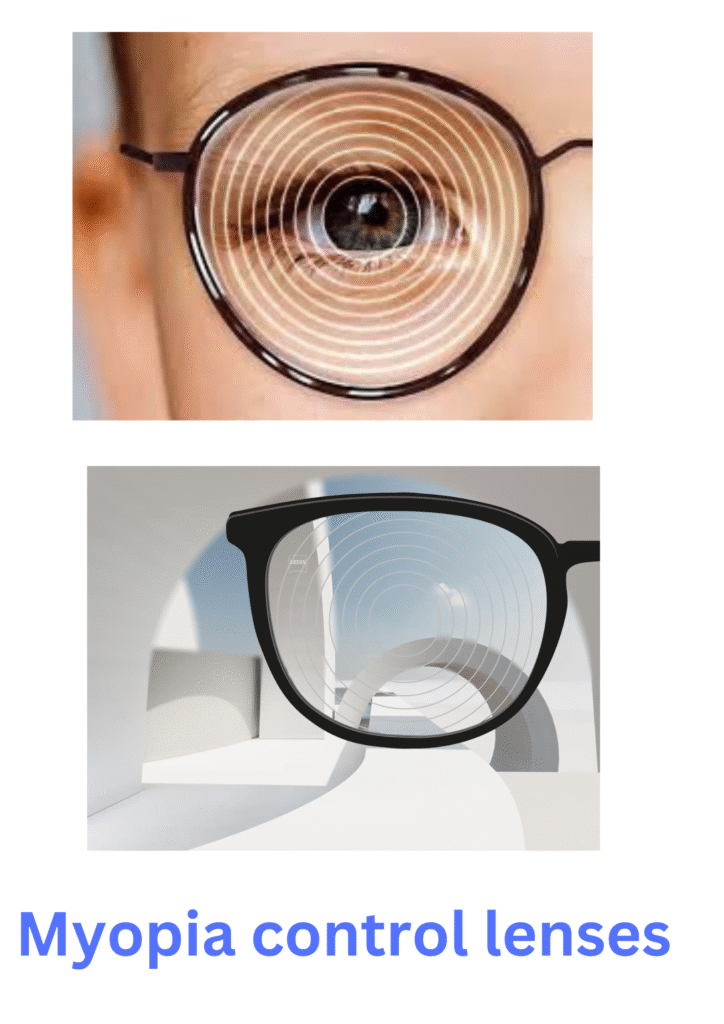THREE-TYPE OF OPTICAL LENS
THERE ARE -Three type of optical Optical Lenses
SINGLE VISION LENSE –
A Single vision Implies only 1 vision in lens, either near, intermediate and far sight. or Single vision lenses are a type of eyeglass lens designed to correct only one field of vision

1. Single vision lenses have one single prescription across their entire surface.
2. This single prescription can be for Near vision, Intermediate Vision or Distance Vision.
FOR EXAMPLE-
1-FOR SINGLE VISION FOR DISTANCE

2-FOR SINGLE VISION FOR NEAR

BIFOCAL LENS–
in bifocal lenses clear demarcation between near and far sighted are-is there Implies 2 prescription in one Lens.

1. Bifocal Lenses are those that have two TYPE –
A. Distance + near or
B. Intermediate + near or
C. Intermediate + distance

Types of Bifocal Lenses–
THERE ARE TWO TYPE OF BIFOCAL LENSES
2.Kryptok Bifocal
Flat Top Bifocal-
1. Also called as D Bifocal
2.. Less Optical Refractions
3.Cheaper Alternative to Progressive lenses.
4.Dividing line causes problems. Ex : While climbing Stairs.
5.Image jump is less as compared to KT bifocal.

Who is Naveen Sharma SEO
Kryptok Bifocal–
1.. Also called as Round (o) Bifocal
2.. Segment edges do not collect dirt
3.. Segment do not fall out of chip
4.Cheaper Alternative to Progressive lenses.
5.. Cosmetically more appealing than D Bifocal
6.Image jump is more as compare to D

PROGRESSIVE LENSES-
In Progressive lenses Implies multiple focal points in one Lens.Here there is no demarcation between near and far sighted area.

Progressive lens is a lens designed for people who have presbyopia with power gradually increasing from Distance zone through a progression in the Near zone
Progressive lens looks like a single vision lens.

Why Progressive Lens?
Progressive has 3 distinct zones of vision-
1-Distance
2-Intermediate
3-Near

Bifocal on the other hand only has 2 zones due to which a wearer cannot see the Intermediate zone clearly
These 3 zones of vision blend together seamlessly, providing the wearer with a continuous depth of field from near to far

Progressive Lens : Advantage over Bifocal
1.Complete range of work distance

2.Poor Head position /Natural Head position

3.Comfortable near & intermediate work

4.No Image Jump

5.Improved Appearance

Progressive Lens : Design
The optical surface of a progressive lens can be divided into the following areas:

1.Distance from fitting point to the reading area is called corridor
2.The upper area of the lens corrects far vision.
3.The lower area corrects the near vision
4.In the middle, the progression area (corridor) allows to switch from a vision to another and serves as the intermediate portion
Progressive Lens : Corridors
1.. A corridor is the small, hour glass shaped area of the lens that the eye follows to get from the distance prescription – through the intermediate – to the reading prescription
2.In other words : It is the intermediate zone.
3.It determines the field of vision.
4.The length of the corridor will determine the progression of power.
5.It is the corridor that lens designers focus on when creating the optimum progressive

Progressive Lens : Corridor Design
THERE ARE TWO TYPE OF DESIGNE
1.Soft design lenses

- offer a narrow distance and near zones.
- . Wide intermediate zone.
- Longer Progression.
- More natural vision due to less noticeable areas of distortion on lens periphery.
- Better for those that have difficulty adapting to the edges of the corridor in the hard/short corridor design.
2.Hard design lenses

- offer a wide distance and near zones.
- Narrow intermediate zone.
- Shorter Progression.
- Drawbacks: This gives a much clearer reading and distance portion, but can cause, dizzy feeling when the eye travels through the narrow corridor


Pingback: Who is Naveen Sharma SEO
Pingback: FIVE TYPE OF PROGRESSIVE LENS IN INDIA